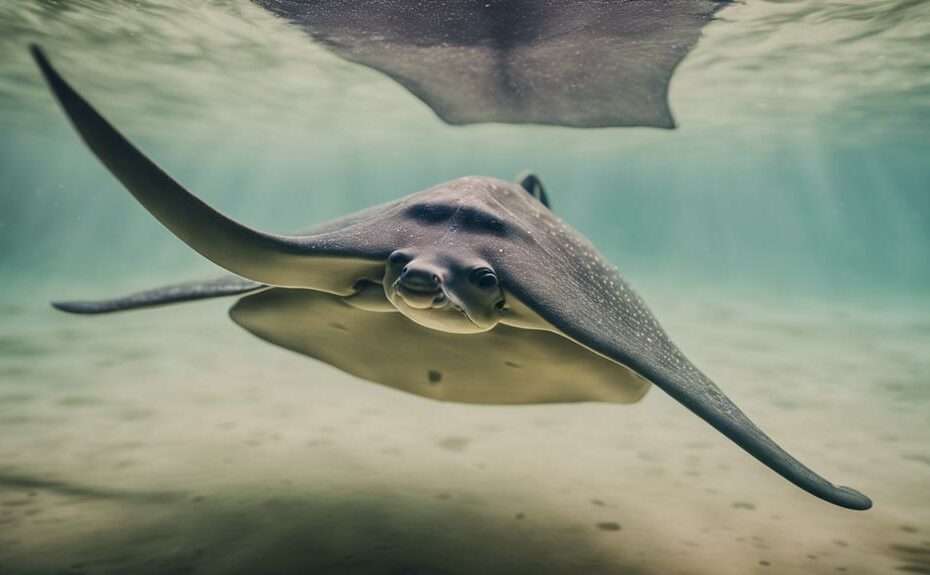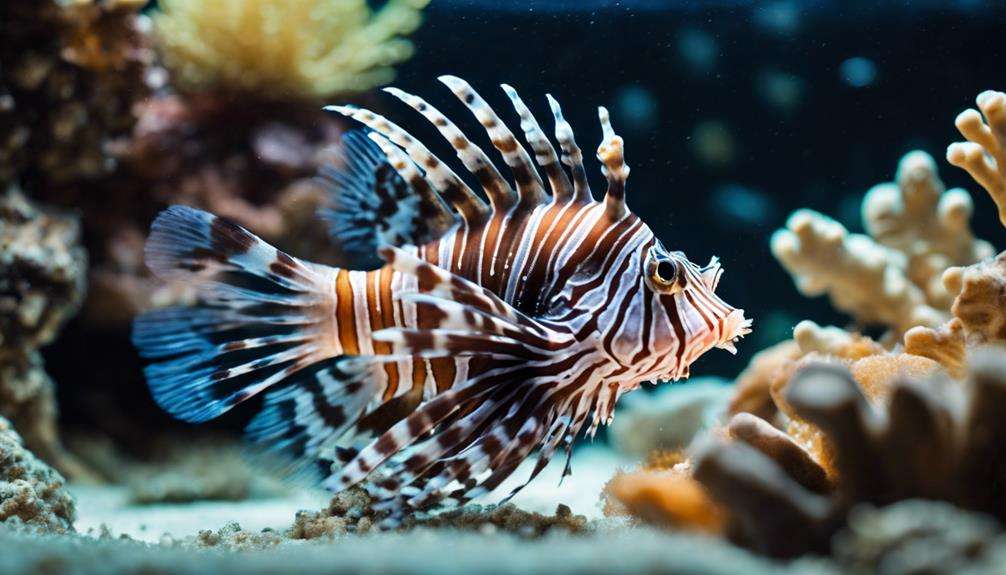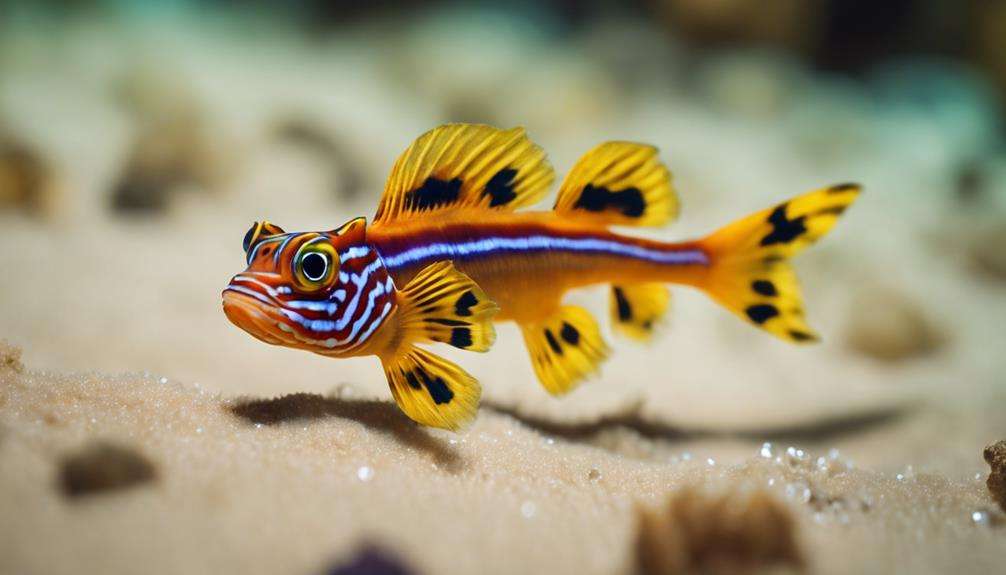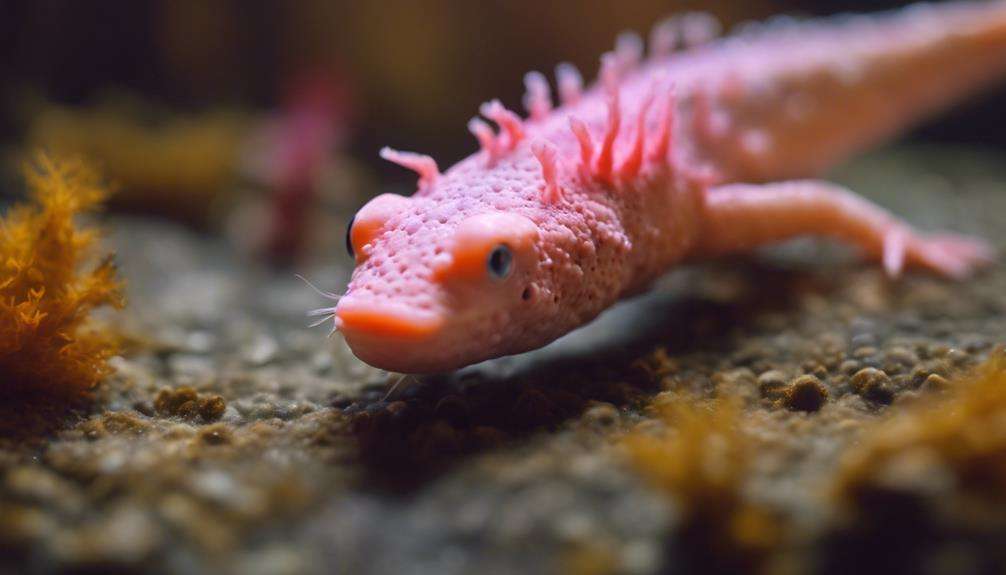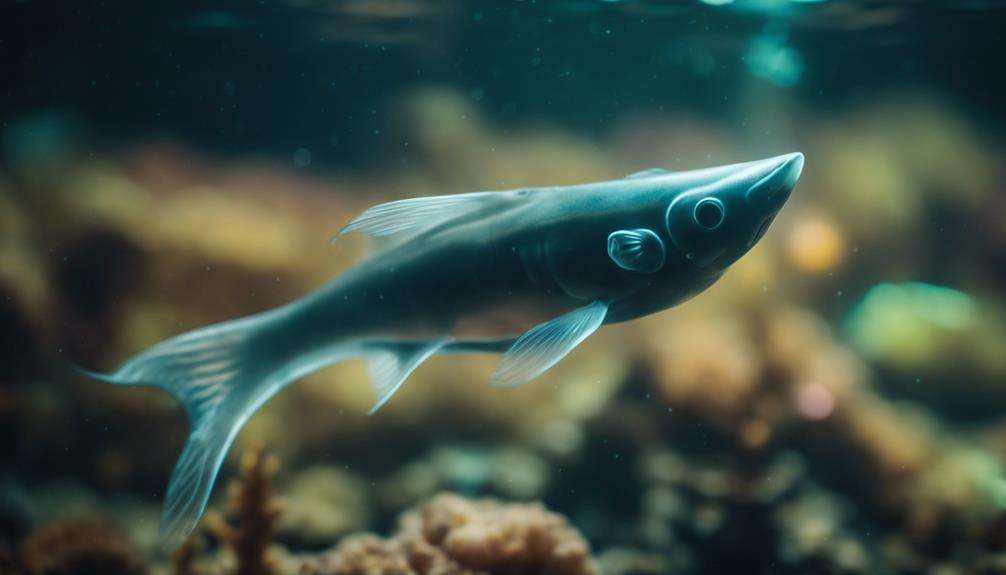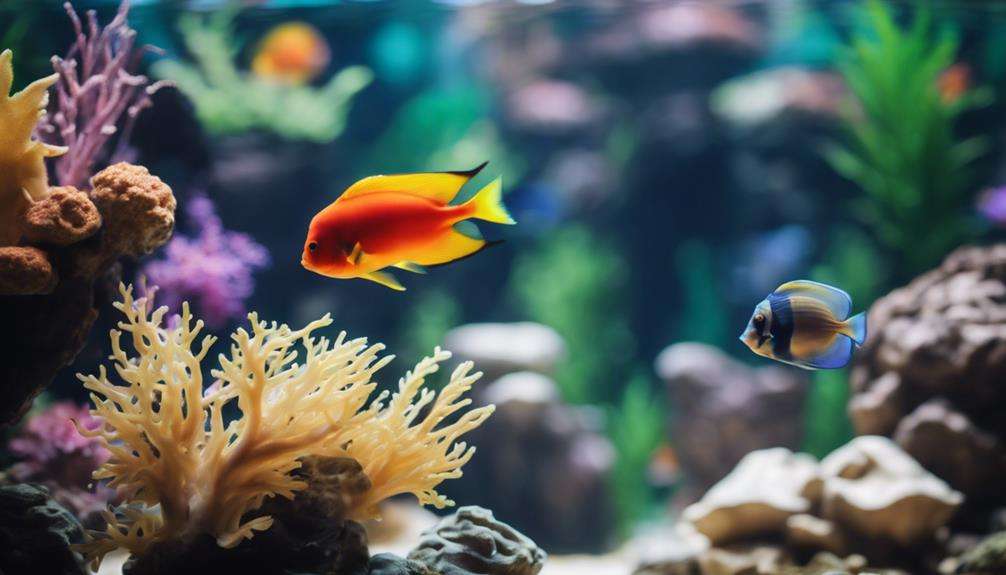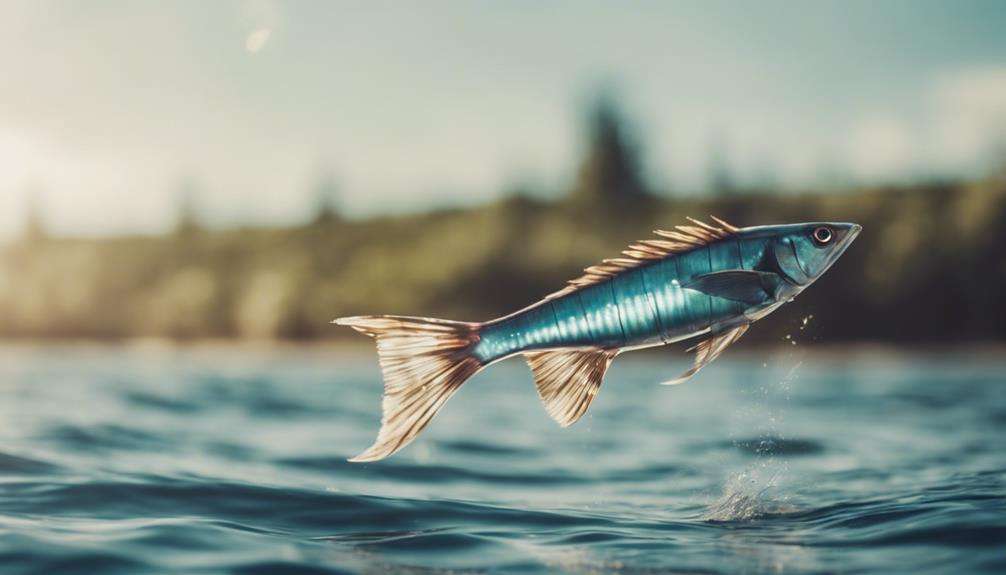You know the saying, 'still waters run deep,' and freshwater stingrays exemplify this notion with their enigmatic nature.
These unique fish pets possess intriguing features that set them apart from typical aquarium inhabitants.
From their graceful movements to their specialized sensory abilities, freshwater stingrays offer aquarists a glimpse into a fascinating underwater world unlike any other.
Key Takeaways
- Freshwater stingrays possess colorful patterns, venomous barbs, and saw-like spines for defense.
- Exotic stingrays demand specialized care, large tanks, and pristine water conditions.
- Conservation efforts are vital to combat habitat destruction and illegal fishing threats.
- Freshwater stingrays contribute to ecosystem balance and biodiversity, warranting protection and conservation.
Physical Characteristics of Freshwater Stingrays
Freshwater stingrays exhibit a distinctive physical structure, characterized by a flattened body shape that helps them seamlessly glide through the water. Their eyes are positioned atop their disc, granting them an excellent field of vision to spot prey or potential threats. The mouth and gill slits are located underneath the body, allowing for efficient feeding and respiration. Additionally, these stingrays possess saw-like spines along their tails, which serve as a defense mechanism against predators and aid in hunting for food. Their colorful dorsal patterns, adorned with spots, not only enhance their aesthetic appeal but also provide camouflage in their natural habitat, the Amazon River.
The disc width of freshwater stingrays can reach an impressive 18 inches, making them a striking presence in any aquarium. With tails stretching about 1 foot in length and a width of approximately 1 inch, these creatures are well-equipped for navigating their aquatic environment. Their carnivorous diet, consisting of crustaceans and invertebrates, showcases their unique feeding habits, making them intriguing additions to the ecosystem they inhabit.
Unique Adaptations of Freshwater Stingrays
With their venomous barbs and specialized sensory organs, freshwater stingrays showcase a remarkable array of unique adaptations that distinguish them from other aquatic species. These adaptations include:
- Venomous Barbs: Freshwater stingrays possess venomous barbs on their tails for defense, a feature uncommon among most other freshwater fish.
- Lorenzian Ampullae: Specialized Lorenzian ampullae on their heads enable stingrays to detect electrical impulses in their environment, aiding in navigation and prey detection.
- Flattened Body Shape: The flattened body shape of stingrays, with eyes on top and gill slits underneath, is a unique adaptation suited for their benthic lifestyle.
- Colorful Dorsal Patterns: Stingrays are known for their colorful dorsal patterns and spots, enhancing their visual appeal and serving as a form of camouflage in their habitat.
- Defensive Capabilities: Their long tails feature saw-like spines that contribute to their distinctive appearance and serve as a defense mechanism against potential threats.
These adaptations collectively make freshwater stingrays fascinating and unique creatures to observe and care for in an aquatic environment.
Rare Freshwater Stingray Species
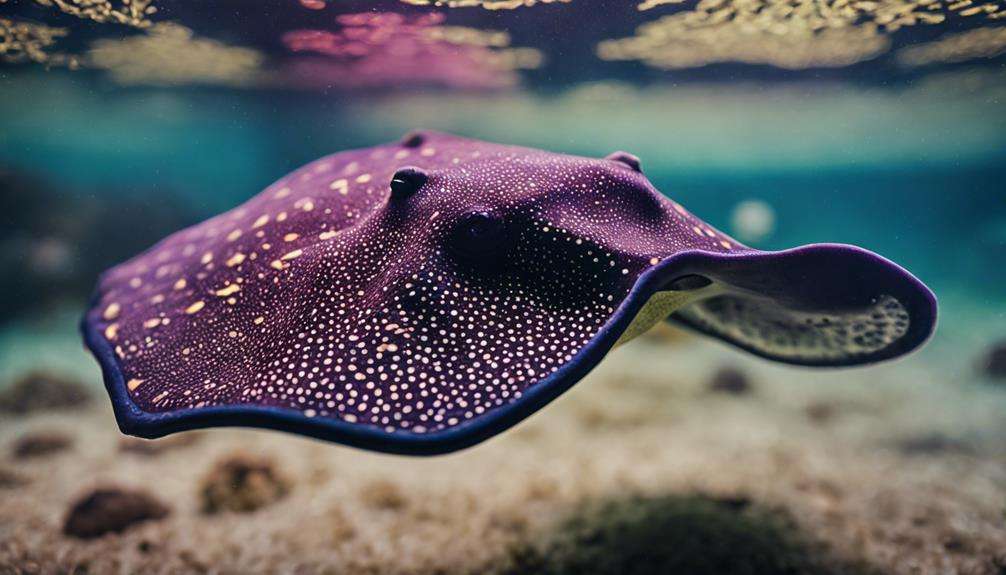
Rare freshwater stingray species exhibit remarkable characteristics that set them apart from more common varieties. The Xingu River stingray boasts vivid coloration and intricate patterns, captivating enthusiasts with its beauty.
Similarly, the Black Devil stingray's mysterious allure, characterized by its striking black coloration, adds an air of mystique to freshwater aquariums.
Uncommon Stingray Varieties
Featuring distinctive patterns and colors, uncommon stingray varieties among freshwater species offer intriguing options for aquarium enthusiasts seeking unique additions to their setups.
- The Black Diamond Stingray is a rare freshwater stingray species with a striking black coloration adorned with white spots.
- The Pearl Stingray showcases iridescent white spots resembling pearls on a dark background.
- The Polka Dot Stingray displays a unique pattern of small, round spots across its body, making it a sought-after species.
- The Galaxy Stingray exhibits a mesmerizing pattern reminiscent of a celestial galaxy, with intricate designs and colors on its disc.
- The Zebra Stingray stands out with bold black and white stripes on its disc, making it a visually striking and rare addition to any freshwater aquarium.
Exotic Freshwater Stingrays
Exotic freshwater stingrays, such as the Tiger River Stingray and Ocellate Freshwater Stingray, exhibit captivating color patterns and unique body shapes that intrigue advanced hobbyist aquarium enthusiasts. These rare species, like the Xingu River Stingray, Black Devil Stingray, and Porcupine River Stingray, are prized for their striking appearances.
To ensure their well-being, these exotic freshwater stingrays require specialized care, large tank sizes, and proper water conditions in captivity. Hobbyists dedicated to these unique fish find joy in the challenge of creating suitable environments for them. Providing the necessary care for these rare stingrays offers a rewarding experience, allowing enthusiasts to observe and appreciate their distinct characteristics up close.
Unique Stingray Species
Moving from the discussion on exotic freshwater stingrays, the unique stingray species, particularly the Tiger River Stingray and Ocellate Freshwater Stingray, stand out for their distinct physical characteristics and captivating features. These rare freshwater species include:
- Tiger River Stingray: Known for its vibrant orange coloration and unique patterns on its dorsal surface.
- Ocellate Freshwater Stingray: Features distinctive ocelli or eye-like spots on its body, making it a sought-after species among stingray enthusiasts.
- Xingu River Stingray: Originates from the Xingu River in Brazil and prized for its striking black coloration with white spots.
- Black Devil Stingray: Rare and elusive species with a dark black body, known for its secretive nature.
- Porcupine River Stingray: Characterized by a spiky appearance resembling a porcupine, making it a fascinating addition to a stingray collection.
Specialized Diet of Freshwater Stingrays

Freshwater stingrays exhibit a specialized carnivorous diet, primarily consisting of live or frozen foods such as shrimp, fish, worms, and crustaceans. These unique fish pets require a varied diet to thrive, including blackworms, frozen bloodworms, mysis shrimp, and raw shrimp to ensure they receive a diverse range of essential nutrients. In addition to these live and frozen options, freshwater stingrays can be trained to eat sinking pellets or tablets, providing a balanced nutritional intake.
Feeding freshwater stingrays is an interactive experience, as they can be hand-fed or enticed to eat from tweezers. This hands-on approach not only ensures that the stingrays are consuming an adequate amount of food but also allows for monitoring of their feeding habits and preferences. By offering a combination of live, frozen, and pellet foods, caretakers can guarantee that their freshwater stingrays are receiving all the necessary nutrients for optimal health and growth.
Habitat Requirements for Freshwater Stingrays
To provide a suitable environment for freshwater stingrays, ensure that the habitat includes slow-moving sandy bottomed rivers with ample swimming space and hiding spots like submerged logs or plants. Freshwater stingrays thrive in habitats that mimic their natural riverine homes. When setting up a tank for these unique fish pets, consider the following:
- Aquarium Size: Provide a large and spacious aquarium to accommodate their size and swimming needs.
- Filtration Systems: Install appropriate filtration systems to maintain water quality and clarity.
- Decorations: Use smooth decorations to prevent injuries to the delicate bodies of freshwater stingrays.
- Water Parameters: Monitor and regulate water parameters such as pH and temperature to ensure a stable environment.
- Hiding Spots: Incorporate hiding spots like submerged logs or plants to allow freshwater stingrays to exhibit their natural behaviors and feel secure in their habitat.
Creating a habitat that meets these requirements is essential for the health and well-being of freshwater stingrays in captivity.
Caring for Freshwater Stingrays in Captivity
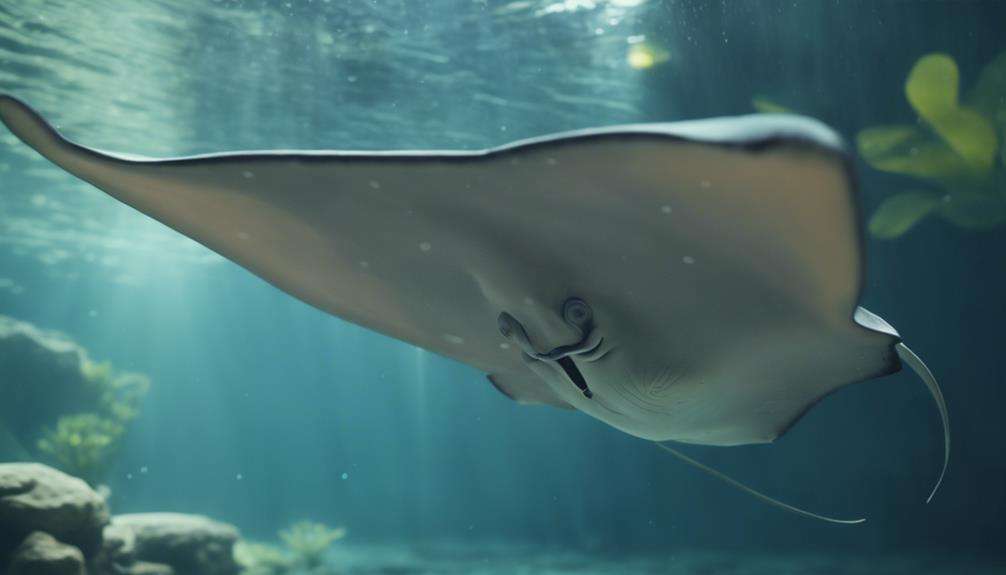
Ensuring the health and well-being of freshwater stingrays in captivity requires meticulous attention to their dietary needs and water quality. These unique fish pets need large aquariums, with a minimum tank length of 72 to 84 inches, to thrive. Maintaining proper water conditions is crucial, with a pH between 6.8 and 7.6 and zero levels of ammonia and nitrite. Freshwater stingrays are sensitive to ammonia, nitrite, and nitrate levels, necessitating frequent water changes and the use of RO/DI water.
Since stingrays spend most of their time at the bottom of the tank, providing a suitable substrate like fine sand and smooth decorations is crucial for their comfort. Being carnivorous, they can be fed a diet of live blackworms, frozen bloodworms, mysis shrimp, and raw shrimp. It's even possible to train them to eat from tweezers or by hand.
Attention to these details is essential when caring for freshwater stingrays in captivity.
Conservation Efforts for Freshwater Stingrays
Amidst the challenges faced by freshwater stingrays in their natural habitats, efforts to conserve these unique fish species are crucial for their long-term survival. Conservation of freshwater stingrays involves various strategies and initiatives to mitigate the threats they encounter:
- Habitat destruction and pollution directly impact the delicate ecosystems where freshwater stingrays reside, jeopardizing their survival.
- Successful breeding programs, such as those at the Smithsonian's National Zoo, play a vital role in ensuring the genetic diversity and sustainability of freshwater stingray populations.
- Illegal fishing practices targeting freshwater stingrays for the aquarium trade pose a severe risk to their numbers in the wild.
- Protection of freshwater habitats is essential to safeguarding the homes of these fascinating creatures and maintaining the balance of their ecosystems.
- Enforcement of conservation laws is crucial to combat activities that threaten the well-being of freshwater stingrays and their habitats. By supporting conservation efforts and raising awareness, we can contribute to the preservation of these remarkable fish pets for future generations.
Frequently Asked Questions
What Makes a Stingray Unique?
Stingrays are unique due to their venomous barbs, Lorenzian ampullae for sensing electric impulses, flattened bodies with eyes on top, and saw-like spines on long tails. Their colorful patterns make them distinct and fascinating pets.
Why Are Freshwater Stingrays Illegal?
Freshwater stingrays are illegal due to concerns about environmental impact, breeding restrictions, conservation efforts, legal repercussions, import/export laws, potential dangers, ethical considerations, black market trade, and protection of endangered species. Regulations aim to safeguard ecosystems.
Why Do Aquariums Let You Pet Stingrays?
When you visit an aquarium, petting stingrays provides a hands-on experience to observe their unique behavior and anatomy up close. It fosters a connection with these creatures, promoting conservation efforts and educating visitors.
Is a Freshwater Stingray a Fish?
Yes, a freshwater stingray is indeed a fish. Its classification is based on scientific criteria like its anatomy, habitat, and evolutionary history. As an aquatic creature, this unique species embodies the beauty of a marine animal in a freshwater habitat.
Conclusion
You have successfully provided the necessary care for your freshwater stingray, ensuring its health and well-being. However, despite your efforts, you may never fully understand the depths of their mysterious nature, as they continue to surprise and intrigue with their unique adaptations and behaviors.
Remember, in the world of freshwater stingrays, there's always more to learn and discover, keeping you on your toes as a dedicated aquarist.
